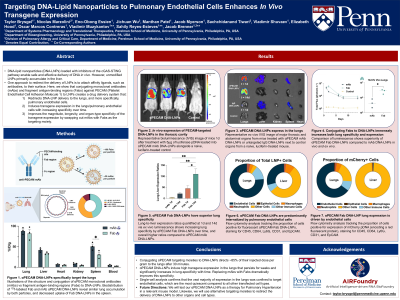Gene Delivery and Gene Editing (Focus Group - GDGE)
(160) Targeting DNA-Lipid Nanoparticles to Pulmonary Endothelial Cells Enhances In Vivo Transgene Expression

Introduction: In recent years, lipid nanoparticles (LNPs) have emerged as a versatile drug delivery system due to their ability to encapsulate therapeutic nucleic acids (1). When injected intravenously, most LNPs accumulate in the liver, limiting their delivery to other organs (2). This restricts the potential application of LNPs to treat cell-type specific diseases, such as pulmonary arterial hypertension (PAH). PAH occurs when pulmonary arterioles are narrowed, often due to overactive serotonin growth factor production in pulmonary artery endothelial cells (PAECs) (3).
Learning Objectives:
- Explain the role of PECAM-1 in endothelial cell targeting in the pulmonary vasculature
- Evaluate the ability to use targeted LNPs to deliver and express gene editing machinery
Taylor Brysgel1*, Nicolas Marzolinii2*, Eno-Obong Essien1, Jichuan Wu3, Manthan Patel1, Jacob Myerson1, Sachchidanand Tiwari3, Vladimir Shuvaev1, Elizabeth Hood1, Oscar Marcos Contreras1, Vladimir Muzykantov1**, Sahily Reyes-Esteves1**, Jacob Brenner1,3**
1)Department of Systems Pharmacology and Translational Therapeutics, Perelman School of Medicine, University of Pennsylvania, Philadelphia, PA, USA
2)Department of Bioengineering, University of Pennsylvania, Philadelphia, PA, USA
3)Division of Pulmonary Allergy and Critical Care, Department of Medicine, Perelman School of Medicine, University of Pennsylvania, Philadelphia, PA, USA
* Denotes Equal Contribution, ** Co-Corresponding Authors
1)Department of Systems Pharmacology and Translational Therapeutics, Perelman School of Medicine, University of Pennsylvania, Philadelphia, PA, USA
2)Department of Bioengineering, University of Pennsylvania, Philadelphia, PA, USA
3)Division of Pulmonary Allergy and Critical Care, Department of Medicine, Perelman School of Medicine, University of Pennsylvania, Philadelphia, PA, USA
* Denotes Equal Contribution, ** Co-Corresponding Authors

Taylor V. Brysgel (he/him/his)
PhD Student
University of Pennsylvania
Philadelphia, Pennsylvania, United States

